

COLORCUBE Home Page. Chromatic adaptation. Chromatic adaptation is one aspect of vision that may fool someone into observing a color-based optical illusion, such as the same color illusion.
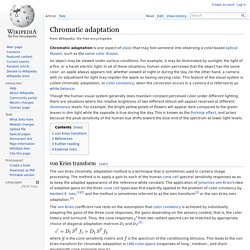
An object may be viewed under various conditions. For example, it may be illuminated by sunlight, the light of a fire, or a harsh electric light. In all of these situations, human vision perceives that the object has the same color: an apple always appears red, whether viewed at night or during the day. On the other hand, a camera with no adjustment for light may register the apple as having varying color. This feature of the visual system is called chromatic adaptation, or color constancy; when the correction occurs in a camera it is referred to as white balance. Though the human visual system generally does maintain constant perceived color under different lighting, there are situations where the relative brightness of two different stimuli will appear reversed at different illuminance levels. Von Kries transform[edit] where References[edit] Brightness. Tints and shades. In common language, the term "shade" can be generalized to furthermore encompass any varieties of a particular color, whether technically they are shades, tints, tones, or slightly different hues;[2] while the term "tint" can be generalized to refer to the any lighter or darker variation of a color (e.g.

Tinted windows).[3] When mixing colored light (additive color models), the achromatic mixture of spectrally balanced red, green and blue (RGB) is always white, not gray or black. Lightness. Three hues in the Munsell color model.
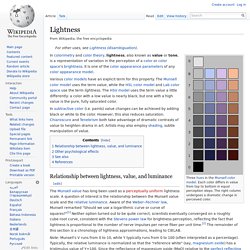
Each color differs in value from top to bottom in equal perception steps. Color theory. Philipp Otto Runge’s color sphere (Farbenkugel), 1810.
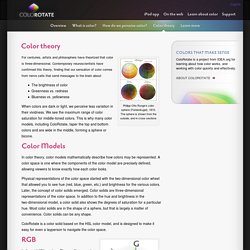
The sphere is shown from the outside, and in cross-sections For centuries, artists and philosophers have theorized that color is three-dimensional. Contemporary neuroscientists have confirmed this theory, finding that our sensation of color comes from nerve cells that send messages to the brain about: CMYK color model. Color printing typically uses ink of four colors: cyan, magenta, yellow, and key (black).
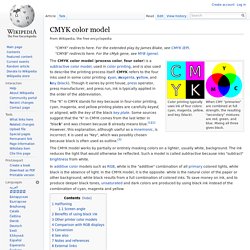
When CMY “primaries” are combined at full strength, the resulting “secondary” mixtures are red, green, and blue. Mixing all three gives black. Color model. A color model is an abstract mathematical model describing the way colors can be represented as tuples of numbers, typically as three or four values or color components.
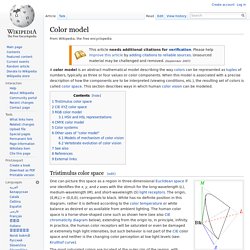
When this model is associated with a precise description of how the components are to be interpreted (viewing conditions, etc.), the resulting set of colors is called color space. This section describes ways in which human color vision can be modeled. Tristimulus color space[edit] 3D representation of the human color space. One can picture this space as a region in three-dimensional Euclidean space if one identifies the x, y, and z axes with the stimuli for the long-wavelength (L), medium-wavelength (M), and short-wavelength (S) light receptors. RGB color model. Hue. An image with the hues cyclically shifted in HSL space The hues in this image of a Painted Bunting are cyclically rotated over time.
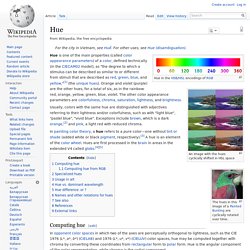
Computing hue[edit] Untitled Document. Theory of Colours. Translated from the German: With Notes By Charles Lock Eastlake "Cicero varietatem propriè in coloribus naaci, hinc in alienum migrare existimavit.
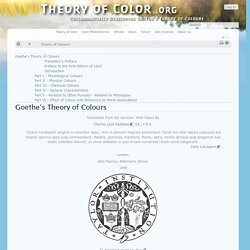
Certè non alibi natura copiosius aut majore lasciviá opes suas commendavit. Metalla, gemmas, marmora, flores, astra, omnia denique quæ progenuit suis etiam coloribus disinxit; ut venia debeator si quis in tam numerosâ rerum sylvâ caligaverit. London: John Murray, Albemarle Street. To Jeremiah Harman, Esq. Dear Sir, I dedicate to you the following translation as a testimony of my sincere gratitude and respect; in doing so, I but follow the example of Portius, an Italian writer, who inscribed his translation of Aristotle’s Treatise on Colours to one of the Medici.
Translator's Preface In reviewing the history and progress of his opinions and researches, Goethe tells us that he first submitted his views to the public in two short essays entitled "Contributions to Optics. " Theory of Colours. Theory of Colours (original German title Zur Farbenlehre) is a book by Johann Wolfgang von Goethe about the poet's views on the nature of colours and how these are perceived by humans. Published in 1810, it contains detailed descriptions of phenomena such as coloured shadows, refraction, and chromatic aberration. The work originated in Goethe's occupation with painting and mainly exerted an influence onto the arts (Philipp Otto Runge, J. M. W. Color theory. In the visual arts, color theory is a body of practical guidance to color mixing and the visual effects of a specific color combination.

There are also definitions (or categories) of colors based on the color wheel: primary color, secondary color and tertiary color. Although color theory principles first appeared in the writings of Leone Battista Alberti (c.1435) and the notebooks of Leonardo da Vinci (c.1490), a tradition of "colory theory" began in the 18th century, initially within a partisan controversy around Isaac Newton's theory of color (Opticks, 1704) and the nature of so-called primary colors. From there it developed as an independent artistic tradition with only superficial reference to colorimetry and vision science. Color abstractions[edit] The foundations of pre-20th-century color theory were built around "pure" or ideal colors, characterized by sensory experiences rather than attributes of the physical world.
Thus, the visual impact of "yellow" vs. Achromatic colors[edit] Colorfulness. Original image, with relatively muted colors L*C*h (CIELAB) chroma increased 50% HSL saturation increased 50%; notice that changing HSL saturation also affects the perceived lightness of a color CIELAB lightness preserved, with a* and b* stripped, to make a grayscale image In colorimetry and color theory, colorfulness, chroma, and saturation are related but distinct concepts referring to the perceived intensity of a specific color.
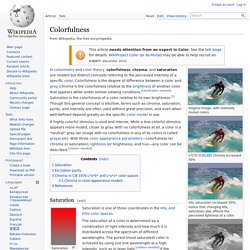
Colorfulness is the degree of difference between a color and gray.